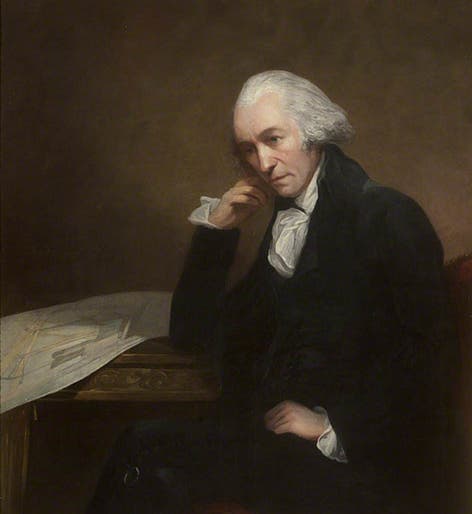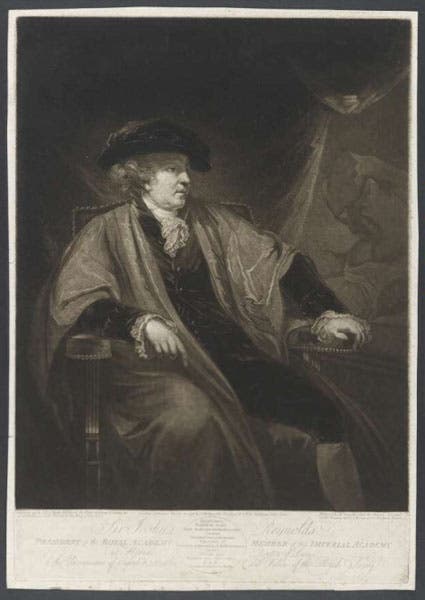Scientist of the Day - Carl Fredrik von Breda
Carl Fredrik von Breda, a Swedish painter, died Dec. 1, 1818, at the age of 59. Breda trained at the Royal Academy of Art in Stockholm, and then embarked with his young family for London around 1788, where he learned the finer points of portraiture from Joshua Reynolds. He then set up his own portrait studio on James Street, quickly attracting an enthusiastic and wealthy clientele, for he was an excellent portraitist. He would return to Sweden in 1796, by invitation of the King, and spend his remaining 22 years as the Royal portrait painter in Stockholm.
We include Breda as a Scientist of the Day because, in 1792, he visited Birmingham and met some of the members of the Lunar Society, painting portraits of three of them: James Watt, inventor of the steam engine; Matthew Boulton, manufacturer with Watt of industrial steam engines, and William Withering, the botanist and chemist who discovered digitalis. Each of these portraits is nearly life-size, and we show them all here. That of Watt is dark and moody, as was its subject (first image). The portrait of Boulton is forceful and strong, just like Boulton (second image), and that of Withering is what you might expect of a portrait, even a very good one, of a botanist/chemist (third image). There are three versions of the Watt portrait to be found, in the Institution of Mechanical Engineers and the National Portrait Gallery in London, and in a private Swedish collection, and at least two of Boulton's, at the Birmingham Museum and in Sweden. The Withering portrait. in the National Museum in Stockholm.
When Breda was invited to become Royal Painter to the King of Sweden in 1796, mezzotint prints of many of his English portraits were immediately issued for sale in London, and these are compelling in their own way, as good mezzotints tend to be. We show here a mezzotint of Breda’s portrait of Watt, engraved by Samuel W. Reynolds (fourth image).
Breda at some point met the distinguished former Birmingham residents, Joseph Priestley and his wife Mary, and while he never painted Joseph (as far as I know), he did paint a powerful portrait of Mary, who was the daughter of one iron-monger (Isaac Wilkinson) and the sister of another (John Wilkinson). This painting is now in Birmingham, but it was not painted during Breda's trip to Birmingham, for the Priestley household was sacked and burned by a mob in 1791, and the Priestleys fled to London (and in 1794, to the United States). So the portrait of Mary, dated 1793, must have been painted back in London (fifth image). You can learn more about the mob attack at our post on Priestley.
Breda also painted a portrait of his teacher, Joshua Reynolds. There are many portraits and self-portraits of Reynolds, but Breda's version is one of the best. I am not sure where the original oil resides, but the mezzotint print of 1796 is powerful in its own right (sixth image). This print is in the British Museum.
It is a historical shame that Breda did not paint the rest of the Lunar Society: Erasmus Darwin, Josiah Wedgwood I, and James Keir (John Whitehurst and William Small had died before Breda made it to Birmingham). But these members lived in Staffordshire (Wedgwood and Keir) or in Derby (Darwin), and they probably did not make it to Birmingham when Breda was there. That is too bad. I would love to see Breda’s take on both Darwin and Wedgwood.
As for his own portrait, there is only one of Breda, done by himself before he left for England in 1788. I cannot find the original oil painting, so I link here to the black-and-white reproduction on Wikipedia. I do not like monochrome copies of portraits in oils, so I prefer not to include it with this post.
There are lots of other portraits by Breda to be found in British and Swedish museums, if you like his style, but they mostly depict royalty and landed gentry and their families. The only other portrait I found by Breda that might have been a candidate for inclusion is that of Emmanuel Swedenborg. The Swedes consider him to be a natural philosopher. But I do not. However, you may admire his beautiful blue wool coat, as painted by Breda, at this link.
William B. Ashworth, Jr., Consultant for the History of Science, Linda Hall Library and Associate Professor emeritus, Department of History, University of Missouri-Kansas City. Comments or corrections are welcome; please direct to ashworthw@umkc.edu.












